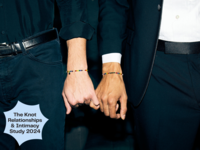The Three Stages of Every Relationship

Although romantic relationships feel unique and special, they usually progress through three phases. To understand these universal stages, we spoke with two acclaimed experts. Dr. Carrie Cole, the Research Director for The Gottman Institute and a certified Gottman therapist, has been in the field of psychology for nearly 30 years. Dr. Marni Feuerman is a psychotherapist in South Florida and the author of Ghosted and Breadcrumbed, Stop Falling for Unavailable Men and Get Smart About Healthy Relationships. In practice for more than 25 years, she's specialized in helping couples with their romantic relationships for more than a decade.
The 3 Stages of a Relationship Timeline
There are three phases of love, according to Dr. John Gottman, the foremost researcher on the topic, says Dr. Feuerman. Couples fall in love, develop trust and build commitment—with each phase varying in duration. Although partners need not experience each stage or go through them sequentially, they do need to effectively navigate whichever stage they're in to have a healthy and satisfying relationship, says Dr. Feuerman.
Stage 1: Falling in Love
Dr. Feuerman describes the first phase (also called limerence or infatuation) as euphoric. "There are high levels of dopamine, which is the chemical that activates pleasure and the brain's reward system, similar to a cocaine rush," she adds. Lust and touch dominate, sometimes blunting people's judgment and awareness of red flags and incompatibilities.
The duration lasts anywhere from months to a lifetime, explains Dr. Cole. Usually, it caps at two years, says Dr. Feuerman—with some data showing that couples whose limerence phase lasts the longest are more successful in their relationships, she shares. Good news for long-time couples: they can re-ignite this phase with effort, explains Dr. Cole, like romantic acts and lots of physical touch.
Stage 2: Developing Trust
After limerence, couples progress to the trust phase, says Dr. Cole. Whereas in the limerence phase, partners are obsessed with their loved ones, now they see how their new relationships fit into their lives. Basically, they put their partner's trustworthiness to the test, she adds, assessing whether they'll be reliable. If they got stranded, would their partner pick them up? If they needed money, would their loved one provide it? Can they trust their significant other to take care of them emotionally and not hurt them?
Since this phase involves stress-testing the relationship, it's the most common period when breakups occur, she explains. But, if both partners prove their trustworthiness, they should segue to the next phase—unless they realize they have different goals. For instance, maybe one member of the couple wants kids but the other does not.
Couples that continue to the final phase despite a lack of trust could experience serious issues down the line, predicts Dr. Cole. Think: unhappiness and a lack of romance and true intimacy. "If there are major character flaws or if there is a major misalignment in values, there is the danger of continuing a relationship that may not be healthy or truly right," adds Dr. Feuerman. "People form attachments they don't want to let go of in an effort to avoid feelings of loss or loneliness."
Stage 3: Building Commitment
In this final phase, partners choose to be together by committing to and staying loyal to each other, says Dr. Feuerman. They don't think about other potential partners. In a nutshell, they're deciding whether they see their loved one as their best life choice or someone to hang out with until something better comes along, explains Dr. Cole.
What Happens if All Stages of the Relationship Succeed?
If a couple navigates all three phases well, their relationship has a higher success rate. Still, of course commitment doesn't always last, admits Dr. Cole. Partners might initially have similar values and goals, but then change as the years pass, she explains. Plus, if they don't maintain the romance, their relationship can suffer, she adds.
"The last stage requires more of an ongoing effort towards novelty and physical intimacy," explains Dr. Feuerman. "This can be a challenge, as it requires ongoing action and effort to keep the spark alive and not segue into a roommate phase instead." What came quite naturally in the euphoric stage now requires more of a concerted effort, which can be difficult.
Another Way of Viewing Relationship Stages
An alternative model of relationship stages is infatuation, early attachment and deep attachment, explains Dr. Feuerman. While the infatuation phase (basically, limerence) lasts up to a year, early attachment starts at around one year and lasts for up to five years. In this early attachment stage, a portion of the brain linked with feelings of bonding and attachment takes over, she explains.
Between five and seven years is the "crisis stage—most have heard of the "seven-year-itch," she says. If couples acknowledge and embrace each others' flaws through this period, they can move through to a place of deeper attachment with the potential to last a lifetime.























